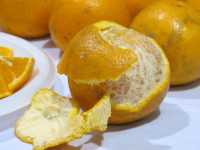Support Set For Wider Citrus Selection

The process of evaluating promising new citrus selections is changing rapidly. In Florida, disease pressure and competitive forces have combined to redefine “necessity.” As Mother Necessity has given birth to invention, industry has sought new ways of more rapidly identifying varieties that may help sustain production or perhaps improve our competitive position. “Citrus Nursery Source” readers have been briefed on the details of UF/IFAS’ innovative FAST TRACK release model. FAST TRACK officially launched last month with nine selections. This month, we will examine efforts within USDA-ARS to move promising selections into the field. Significant effort is being invested in the identification of new and promising material, and this stands to be of great benefit to industry. This comes at a time when grower groups and citrus organizations are calling for an increased emphasis on evaluation of existing plant material.
Soon after New Varieties Development & Management Corp. (NVDMC) was formed, a cooperative agreement was forged with USDA-ARS to move several advanced selections to grower cooperators for trial and evaluation. These efforts resulted in an open release of US Seedless Pineapple orange and a proprietary release and patent of the US Early Pride tangerine. Through this same effort, the US Seedless Surprise (a white-fleshed, low acid grapefruit hybrid) was trialed and recommended for additional research (to induce a red mutation). The process of involving growers in the trial process has proven valuable to the industry and the research community. Plantings in commercial settings, subject to common production practices, yield rapid and practical results that are highly significant to growers. Additionally, trial opportunities provide an opportunity for growers to engage and contribute to the research process, despite continued apprehension (among some) about the risk of commercial plantings.
All Part Of The Plan
Dr. Ed Stover, Dr. Greg McCollum, Randy Driggers, and James Salvatore have developed the framework of a field-trial research plan and have stimulated interest within USDA-ARS leadership to engage in more rapid testing and release of ARS citrus material. Part of this process has been the solicitation of input from stakeholders in all citrus producing states. The NVDMC Board had the opportunity to brainstorm this issue with Dr. Stover in early July and pledged to work closely with ARS to facilitate this process in Florida and to open communication with California and other interested states. Assisting ARS in the establishment of grower trials is consistent with NVDMC’s research trust agreement with USDA.
At presstime, the details of the USDA-ARS early trial process are still in development. Specifics of the program will be ironed out and communicated to the industry when available. We do know that grower cooperators will be asked to provide: space for planting in a commercial setting; typical caretaking practices; access for research staff to make observations and assessments; and in some cases, to reimburse the cost of the trees. This research will inform the ARS release process and is intended to shorten the amount of time necessary to provide growers new citrus options.
Fleshing Out Fruit
Some of the selections fall into the orange-like category. These are orange hybrids (with complex lineage) that show varying levels of apparent (or potential) tolerance to HLB. These selections have the appearance of an orange and in most cases also feature taste and aroma volatiles similar to an orange. One is easy peeling.
ARS also has a collection of mandarin hybrids that need to enter the trial process. These mandarin selections have seeds, but the trees appear relatively healthy under intense disease pressure and some appear to be cold tolerant. Some of the mandarin selections have been irradiated in the hopes of inducing a seedless mutation. Finally, we will need grower-cooperators to plant out trees made from irradiated buds of two grapefruit hybrids: Jackson and SL Surprise. The purpose of this planting is to seek a red mutant of these otherwise promising varieties.
Watch for more information about these positive developments. Nurseries and growers need options. Trials of advanced material will get us one step closer.










